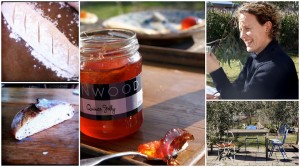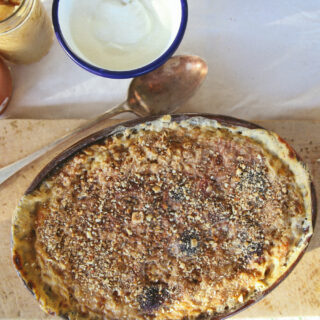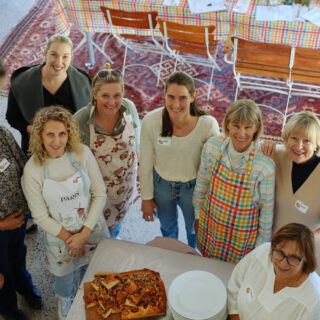We are taking a little family holiday up north this week. And while away I asked if Kate, a good friend and wonderful cook, would do a guest post for me. Kate is the woman behind Lynwood Preserves, here she is above, on the left with her two girls and mum Robbie on the right. The kids and I had visited Kate last school holidays (here’s more on that trip) and when we arrived I gave her a bag of sourdough starter that Mum had given me. I knew she would keep it alive while I would struggle and of course she did. Here is the story…
I was all set to go with enthusiasm to boot. All the books say how wonderful it is to make your own bread. It becomes part of your life’s ritual. It embeds itself as a virtuous part of your daily existence. Gives you a routine, requires discipline. You can wow friends with your own sourdough!!! I need all of these things in my life. The other thing I need is a halfway decent loaf of bread. Living in Collector the options are non-existent. A drive to Canberra, well if I had a routine, then I could build it into my life.
A friend turned up on my doorstep a couple of weeks ago, with all the usual trimmings and well this is a funny thing she said, here is a starter. That was the green light for the bread journey to begin. She said I hope you manage to keep it alive. I fed it some water and flour and bubbles arrived, so yes it is alive and well.
Why sour dough? It feels more authentic, and I like taking the harder path. No powdered yeast, you make your own wild yeast. Others call it a natural fermentation of water and flour. I now have a bubbling jar of fermenting flour and water called a starter living in my fridge. The yeast has come from the air. They say it has longer, slower rises and a better flavour. You need to keep feeding the starter with a bit more flour and water after every bake. If you go away for a week, you can keep it in the fridge to slow down the ferment and keep it alive.
Mum says you can’t make bread loaf by loaf; you need to have the economies of scale on your side. I wanted to prove her wrong. I wanted to try and see what all this fuss is about. All the other recipes and advice I read say it can be done and how easy it is. Well it is far from that, but I have enjoyed the journey. Mind you I have spent a small fortune on organic wholemeal spelt fliour and made about eleven loaves that looked more like bricks. My husband has identified them as a fantastic building material, so he has encouraged me by suggesting that when things get tough we could always eat the spare room.
We have had puddles of dough in front of the fire spreading wider not higher.
I gave some starter to another friend. She sent me a text to say how well it worked and how do I make more starter? Well that was hard for me to take, particularly with my husband working out what mortar mix to use on the bread bricks I had been churning out. I had a deflated dough and equally flattened enthusiasm. But give it a day or two and the curiosity has me back at the bench, with the sticky mess everywhere.
This is what I learnt; I am not sure it is all in the kneading. Do not wait for it to double in size. Feed the starter and keep it out for a few hours before making the bread. No need to oil the bowl when it is rising. Dust it with semolina after folding and shaping it. Bake it in a cast iron piping hot pan and lid.
Kate’s sourdough bread
200 grams runny goopy starter (I feed my starter wholemeal spelt flour)
400 grams white bakers’ flour
1 tablespoon sugar
1 teaspoon salt
I cup of water
1tspoon semolina flour
Mix all ingredients in a bowl bring it together, and try to leave it as wet as you can. Cover with cling film. Let it stand all day (hopefully you have even wetter dough, and when you tip the bowl and let the dough fall out, it has a stringy look).
Dust the bench and the ball of dough with a bit of flour. Fold the dough in half from four sides, turn upside down and put it on a tea towel dusted with semolina flour. Dust the entire ball of dough too, and cover with the tea towel (amazingly it does not stick to the tea towel) Scrunch up some baking paper 3 times to make it softer and less stiff, and roughly line the pot with it.
In about 2 hours I clumsily get the very floppy ball of dough in to the piping hot cast-iron pot and cook it at 200 degrees Celsius for 25 minutes, the lid off for another 20 minutes. Always cook it longer than you think. I have had many an undercooked loaf. I am sure things will not go smoothly for the first few batches. I am still on the journey and have a long way to go. So press on and do not listen to your mother.
This article was first printed in the Canberra Times, Kate does a regular column for the paper, alternating weeks with her mother Robbie Howard. Many thanks go to both Kate and the Canberra Times for allowing us to reprint it here. Both Robbie and Kate’s past columns can be found on the Lynwood website’s recipe page, they are well worth a read and there are some wonderful recipes written within.











Very interesting Kate! I have a few years of sourdough experiments/mess/baking behind me and now it is part of my routine. I am actually amazed I have stuck to it for so long. I adore it…I get excited about making it…it gets me out of bed early. Strange isn’t it? Lovely post 🙂
If you want to mount a hanging pot rack, make sure that there will be enough clearance. You don’t want to whack yourself in the head with a skillet when you walk through your kitchen.